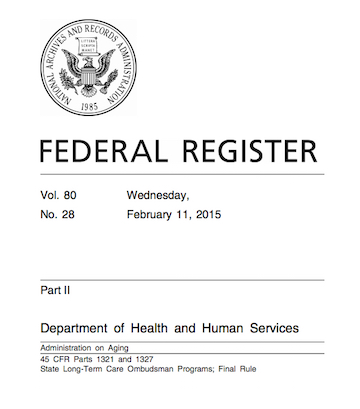
A newly effective federal rule should improve efficiency and consistency in state long-term care ombudsman programs as intended, but it doesn’t go far enough, maintains one organization representing aging services providers.
The rule, effective July 1, aims to help states interpret the Older Americans Act regarding the role of the ombudsman programs in resolving complaints of abuse and other matters on behalf of residents in assisted living communities, nursing homes and other LTC settings, among other goals. States have interpreted relevant provisions of the AOA inconsistently since the ombudsman program began in the 1970s, according to the AOA, because regulations have not focused on states implementation.
The rule was first proposed by the Administration on Aging in 2013 and published in final form in the Federal Register in 2015.
 LeadingAge supports the ombudsman program and applauds the rules’s goals, Cheryl Phillips, M.D., senior vice president of public policy and health services at LeadingAge, told McKnight’s Senior Living. The organization is concerned that significant variation still exists between states and the variation of the role in different settings of care, however, she said.
LeadingAge supports the ombudsman program and applauds the rules’s goals, Cheryl Phillips, M.D., senior vice president of public policy and health services at LeadingAge, told McKnight’s Senior Living. The organization is concerned that significant variation still exists between states and the variation of the role in different settings of care, however, she said.
“We continue to encourage the development of core training standards at a federal level,” Phillips said. The organization had expressed to the AOA its concerns related to training in 2013.
In the final rule, the agency said it plans to develop training standards for the ombudsman program and in the meantime recommends that state programs refer to the National Ombudsman Resource Center, which it funds, for training resources and a core curriculum designed for certification.
LeadingAge also sees potential conflicts or overlap with state licensing agencies because the “best interest” standard, related to residents who are not able to speak for themselves, is not clearly defined and because the new rule allows for broader authority of the ombudsman, Phillips said. “It will be important to align the activities and policies of the ombudsman program with the state regulations,” she added.
Addressing such concerns in the final rule, the AOA wrote: “We understand that determining ‘best interest’ does necessarily require some judgment, but we believe that ombudsmen and representatives of the office are required to use sound judgment in their work on a frequent basis. We further note that ombudsman programs should be familiar with the use of this standard since the [OAA] provides for use of the ‘best interest’ standard in the situation where ‘a representative of the office has reasonable cause to believe that the guardian is not acting in the best interests of the resident.’ …Moreover, the ‘best interest’ standard is commonly used in ethical and professional literature.”
The AOA said it will provide technical assistance regarding the best interest standard in the context of ombudsman program practice.
Representatives for the National Center for Assisted Living and Argentum also told McKnight’s Senior Living that the organizations appreciate the work of the ombudsman programs. Back in 2013, NCAL’s sister organization, the American Health Care Association, sent in one of 85 comments about the proposed rule. AHCA had expressed concern to the AOA that the proposed rule called for expanding ombudsman access to documents beyond what was specified by the OAA. The agency ultimately opted to follow the parameters of the act, NCAL told members in a 2015 newsletter after the final rule was published.
The government delayed implementation of the rule to allow states time to update their regulations and practices. Now that the rule is in effect, the AOA said it will be reviewing states’ progress and will provide training and technical assistance to states, ombudsman programs and others where needed. The AOA has posted frequently asked questions and answers about the rule on its website.



